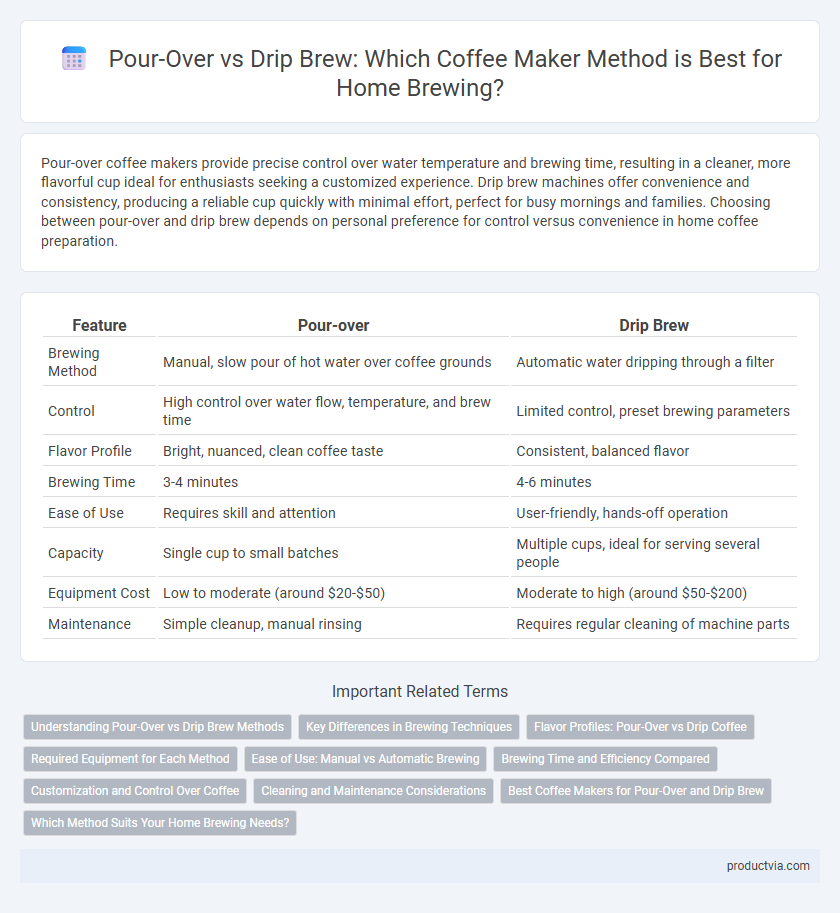Pour-over coffee makers provide precise control over water temperature and brewing time, resulting in a cleaner, more flavorful cup ideal for enthusiasts seeking a customized experience. Drip brew machines offer convenience and consistency, producing a reliable cup quickly with minimal effort, perfect for busy mornings and families. Choosing between pour-over and drip brew depends on personal preference for control versus convenience in home coffee preparation.
Table of Comparison
| Feature | Pour-over | Drip Brew |
|---|---|---|
| Brewing Method | Manual, slow pour of hot water over coffee grounds | Automatic water dripping through a filter |
| Control | High control over water flow, temperature, and brew time | Limited control, preset brewing parameters |
| Flavor Profile | Bright, nuanced, clean coffee taste | Consistent, balanced flavor |
| Brewing Time | 3-4 minutes | 4-6 minutes |
| Ease of Use | Requires skill and attention | User-friendly, hands-off operation |
| Capacity | Single cup to small batches | Multiple cups, ideal for serving several people |
| Equipment Cost | Low to moderate (around $20-$50) | Moderate to high (around $50-$200) |
| Maintenance | Simple cleanup, manual rinsing | Requires regular cleaning of machine parts |
Understanding Pour-Over vs Drip Brew Methods
Pour-over brewing offers precise control over water flow and extraction time, resulting in a cleaner, more nuanced cup suited for single servings, while drip brew machines automate the process to deliver consistent, larger volumes ideal for convenience. Pour-over requires manual technique and attention to detail, using tools like a gooseneck kettle and a cone-shaped filter, whereas drip brewers utilize a built-in showerhead and flat or basket-style filters for hands-off operation. Understanding these differences helps home brewers select the method that balances flavor complexity and ease of use based on personal preference and lifestyle.
Key Differences in Brewing Techniques
Pour-over coffee brewing involves manually pouring hot water over coffee grounds in a circular motion, allowing precise control over water flow and extraction time, resulting in a cleaner and more nuanced flavor profile. Drip brew machines automate this process by evenly dripping water through a coffee filter with grounds, offering convenience and consistency but less control over brewing variables. The main differences lie in user involvement and precision: pour-over requires active attention and skill, while drip brew prioritizes ease and repeatability.
Flavor Profiles: Pour-Over vs Drip Coffee
Pour-over coffee typically delivers a cleaner, brighter flavor with pronounced acidity due to its manual brewing process and precise control over water flow and extraction time. Drip brew generally produces a richer, bolder taste with more body, resulting from automated brewing that allows for higher coffee-to-water ratios and longer contact time. Home brewers seeking nuanced, complex flavor notes often prefer pour-over, while those desiring convenience and consistency might opt for drip brew.
Required Equipment for Each Method
Pour-over coffee requires a cone-shaped dripper, paper or reusable filters, and a gooseneck kettle for precise water pouring, ensuring optimal extraction. Drip brew systems typically use an electric coffee maker with a built-in heating element, basket-style filter holder, and a carafe for automatic brewing and serving. Both methods emphasize filter quality, but pour-over demands manual control equipment, while drip brew prioritizes convenience with automatic components.
Ease of Use: Manual vs Automatic Brewing
Pour-over coffee makers require manual control over water flow and brewing time, demanding more attention and skill from the user. Drip brew machines automate the process with programmable settings, offering consistent results and convenience for busy households. For ease of use, automatic drip brewers provide a straightforward, hands-free experience, while pour-over methods suit those who enjoy a hands-on approach to crafting their coffee.
Brewing Time and Efficiency Compared
Pour-over coffee makers typically require 3 to 5 minutes of brewing time, offering precise control over extraction and enhancing flavor clarity. Drip brew machines generally take 5 to 10 minutes to complete, balancing speed with convenience and allowing for larger batch brewing. Efficiency in pour-over methods favors quality and customization, whereas drip brewers optimize for volume and ease of use in home brewing.
Customization and Control Over Coffee
Pour-over coffee makers offer precise control over brewing variables such as water temperature, pour rate, and coffee grounds saturation, allowing enthusiasts to customize flavor profiles to individual preferences. Drip brew machines provide convenience with programmable settings but generally limit hands-on adjustments, resulting in more consistent yet less personalized coffee. For home brewing, pour-over methods appeal to those seeking maximum customization and control, while drip brewers cater to users prioritizing ease and consistency.
Cleaning and Maintenance Considerations
Pour-over coffee makers typically require more frequent and thorough cleaning due to their manual components, such as ceramic drippers and reusable filters, which can retain coffee oils and residue. Drip brew machines often feature removable, dishwasher-safe parts like filter baskets and carafes, simplifying maintenance and reducing buildup. Regular descaling of both types is essential to prevent mineral deposits and ensure consistent brewing performance.
Best Coffee Makers for Pour-Over and Drip Brew
Pour-over coffee makers, such as the Hario V60 and Chemex, excel in delivering precise control over brewing time and extraction, producing a clean, flavorful cup ideal for coffee enthusiasts seeking customization. Drip brew machines like the Bonavita Connoisseur and Breville Precision Brewer offer convenience and consistency, automating the process with programmable settings while preserving rich aroma and balanced taste. Choosing between pour-over and drip brew depends on desired control and convenience, with the best coffee makers in each category providing reliable performance and enhanced flavor profiles.
Which Method Suits Your Home Brewing Needs?
Pour-over coffee makers offer precise control over water flow and extraction, ideal for those who prioritize flavor complexity and customization in small batches. Drip brew machines suit convenient, larger volume brewing with programmable settings, perfect for busy households needing consistent taste with minimal effort. Choosing between pour-over and drip brew depends on your preference for manual engagement versus automation and the quantity of coffee consumed daily.
Pour-over vs Drip Brew for Home Brewing Infographic

 productvia.com
productvia.com